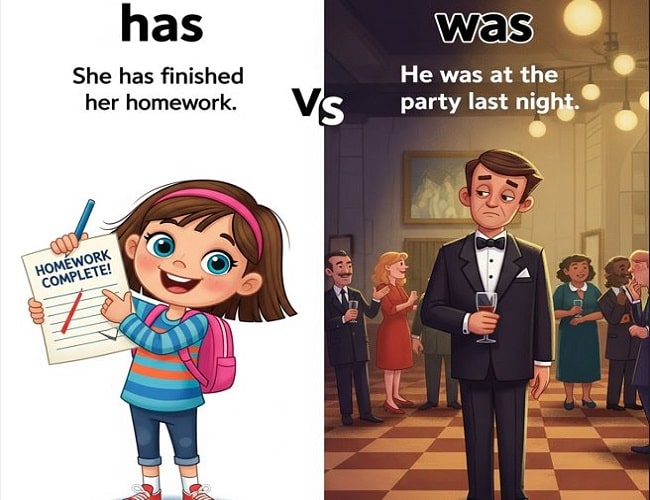Mastering the correct usage of verbs is one of the most important foundations of learning English. Among the most frequently confused verb forms are “has” and “was”, especially for those new to grammar or learning English as a second language. These two words may seem similar, but they belong to different tenses and serve distinct grammatical purposes.
Understanding the differences between “has” and “was” helps you form correct sentences, communicate effectively, and avoid common writing errors. This comprehensive guide is designed for students, ESL learners, and content creators who want to sharpen their English grammar skills and write with confidence.
Understanding the Basics: What Does “Has” Mean?
The word “has” is the third-person singular form of the verb “have” and is used in the Present Perfect Tense. It shows that an action happened at an unspecified time before now, or that an action started in the past and continues to the present.
What is the meaning of has in grammar? It indicates a completed action with a present relevance, especially when used with a past participle.
Examples:
- She has eaten breakfast. (The action is complete, but the result is relevant now – she’s not hungry.)
- He has gone to work. (He’s not here now because of that completed action.)
Structure:
- Subject (third person singular) + has + Past Participle
Understanding “Was”: What Does It Mean?
The word “was” is the past tense form of the verb “to be”, used for singular subjects in the Simple Past Tense. It describes a past state, condition, or location and doesn’t connect to the present moment.
What does was mean in a sentence? It shows that something existed or occurred entirely in the past.
Examples:
- She was late to the meeting. (It happened in the past.)
- He was at the library. (He was there before, not now.)
Structure:
- Subject (singular) + was + Complement
Has vs Was: What’s the Difference?
To avoid confusion, let’s compare their key distinctions:
Tense Difference:
- Has = Present Perfect Tense (connection to now)
- Was = Simple Past Tense (completed in the past)
Subject Agreement:
- Has is used with he, she, it (third person singular)
- Was is used with I, he, she, it (singular subjects in past)
Contextual Usage:
- Has is used when the result still matters now.
- Was is used when you’re only talking about the past.
Has vs Was: What’s the Difference?
Understanding the difference between has and was is essential for using correct verb tenses in English. While both are commonly used, they belong to entirely different grammatical categories. Let’s break down the key differences between them in a detailed and SEO-optimized way.
Differences Between Has and Was With Chart
| Feature | Has | Was |
|---|---|---|
| Tense | Present Perfect Tense | Simple Past Tense |
| Verb Type | Auxiliary verb (used with past participle) | Main verb (past form of “to be”) |
| Used With | Third person singular subjects (he, she, it) | Singular subjects (I, he, she, it) |
| Purpose | Describes actions that affect the present | Describes completed actions in the past |
| Example Usage | She has finished her lunch. | She was at the office yesterday. |
| Time Connection | Ongoing or recently completed actions | Events completely in the past |
Has vs Was Grammar Rules
- “Has” is used in the Present Perfect Tense and is paired with the past participle form of a verb.
- Rule: Subject (he/she/it) + has + past participle.
- “Was” is the Simple Past Tense of “to be” used with singular subjects.
- Rule: Subject (I/he/she/it) + was + complement or adjective.
When to Use Has vs Was Correctly
Use “has” when talking about actions that:
- Have occurred at some point in the past
- Still have relevance or connection to the present
- Example: “She has completed her homework.”
Use “was” when referring to:
- A state or action that occurred entirely in the past
- Something that is no longer true now
- Example: “She was tired yesterday.”
Sentence Examples: Has vs Was in Action
Here’s a side-by-side comparison for clarity:
| Subject | Present Perfect (Has) | Simple Past (Was) |
|---|---|---|
| She | She has visited Paris. | She was in Paris last year. |
| He | He has finished his homework. | He was tired after school. |
| It | It has stopped raining. | It was cold yesterday. |
Read also more related topics: Difference between shall and will
What is the Difference Between Has Been And Have Been?
Difference Between Was and Had
What is the Difference Between Being and Been
Common Grammar Mistakes Using Has and Was
1. Mixing tenses:
- Incorrect: She was finished her homework.
- Correct: She has finished her homework.
2. Using “has” for past-only actions:
- Incorrect: He has gone to the party last night.
- Correct: He was at the party last night.
3. Using “was” when the result is still relevant:
- Incorrect: She was lost her phone.
- Correct: She has lost her phone.
Tips for ESL Learners: Mastering Has vs Was
1. Visual Memory Tricks:
- Think of “has” as something that still matters now.
- Think of “was” as completely in the past.
2. Practice with timelines:
- Draw timelines to understand tense differences visually.
3. Fill-in-the-blank examples:
- He ___ (has/was) traveled to Spain three times.
- She ___ (was/has) not at school yesterday.
Teaching Has vs Was: Lesson Ideas for Educators
1. Simple Explanations:
- Use real-life examples to show the link to time and subject.
2. Interactive Worksheets:
- Matching verbs to tenses
- Sentence correction exercises
3. Dialogues & Role Play:
- Create short conversations using “has” and “was”
Quiz Section: Test Your Understanding
Choose the correct verb:
- She ___ already eaten. (has/was)
- He ___ at the party last night. (has/was)
- It ___ been a long day. (has/was)
- I ___ tired after the trip. (has/was)
Answers:
- has
- was
- has
- was
Give the quiz test about has and was which will help you to grow English grammar skills.
You may practice and give related tests here: Present perfect tense Quiz
Present Perfect continuous quiz
Bonus Section: Has vs Was in Spoken English
1. Casual Speech:
In conversation, contractions and context often clarify tense. (e.g., “She’s gone” instead of “She has gone”)
2. UK vs US Usage:
Generally consistent across dialects, though present perfect (“has”) is more commonly used in British English for recent actions.
3. Informal Variations:
Spoken English may blur lines but grammar rules still apply in writing and formal settings.
Last Word
Now that you understand the key differences between has and was, you’re one step closer to writing and speaking English more accurately. Remember:
- “Has” = present perfect = action relevant now
- “Was” = simple past = finished past event
With regular practice, the confusion will fade and your confidence will grow.

